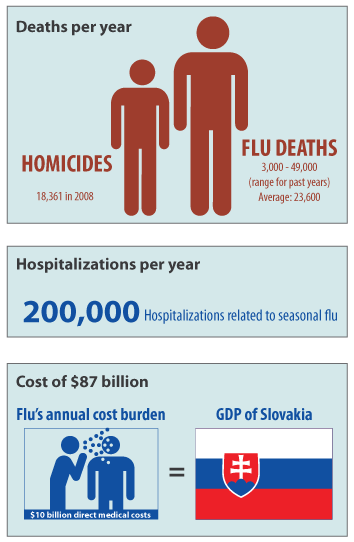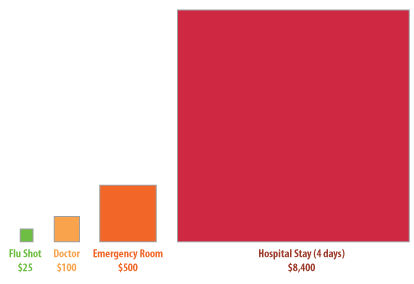This site is about the flu, a major health risk that is often misunderstood. Please explore each page by selecting the tabs above.

|
Vaccines are an essential defense against influenza viruses. Many Americans already get vaccinated every year. But if we increase the coverage then we will benefit from better herd immunity. This protects people at higher risk: babies, the elderly, and the sick. You can see a visualization of herd immunity on the next tab. (Source is CDC) |
| Vaccination Coverage, by Month, of People in the United States | ||||||||||
| August | September | October | November | December | January | February | March | April | May | |
| 2009 — 2010 | ||||||||||
| 2010 — 2011 | ||||||||||
A flu shot is about $20 or $25, though often free if you have insurance. Compare that with the medical costs if you choose not to get the shot and then someone in your family gets the flu. (Source is Aetna)

|
What if you had the flu? How many people might you infect, including others that those people infect, and so on?
|
|||||||||||||||||||||||
This news feed from the CDC will help keep you informed about the seasonal flu.
The authoritative source of flu-related information is the Centers for Disease Control and Prevention. The web site is Flu.gov. To get information targeted to your region simply select your state below.
Or, if you just want to find a flu vaccine clinic you can use this tool:
If you want to watch some very current but unreliable mentions of the flu, you may enjoy the twitter live search for the flu (filtered for English language tweets).
Every time you press the Run Simulation button, a new diagram is drawn. The diagram depicts the network of flu virus transmission. The central node is the player of the simulation, i.e. you. The premise is that you are the index case in the network, i.e. patient zero, the first person in the network to get the flu. The links from each node represent the people contaminated in first few days, when the infected person is is contagious but not symptomatic. So the network is only the people that you pass some of the virus to; then those people are fully infected depending on their immunity and the virulence (strength of the virus). The color red denotes viral infection, blue denotes vaccination, and gray denotes transmission of some virus but without causing full infection in the recipient.
A tree (hierarchical) topology was chosen over the mesh topology that is common for social network diagrams. The advantage of this approach is that a large number of nodes can be drawn without obscuring nodes and links. Note that in this topology some people may be represented by more than one node. This occurs when there is more than one path to a person: for example, if a colleague is also a friend of sibling. But that is an acceptable limitation since the diagram does not depict the entire social network: it is only the transmissions of the virus.
The simulation is controlled by four adjustable levers, which work as follows.
There is a growing field of using gaming for health purposes, including for communication and education. The advantage of an interactive, game-like experience for communicating health information is that it can often be more engaging and consequently more effective. Some of the research in this area can be found through the national Health Games Research project.